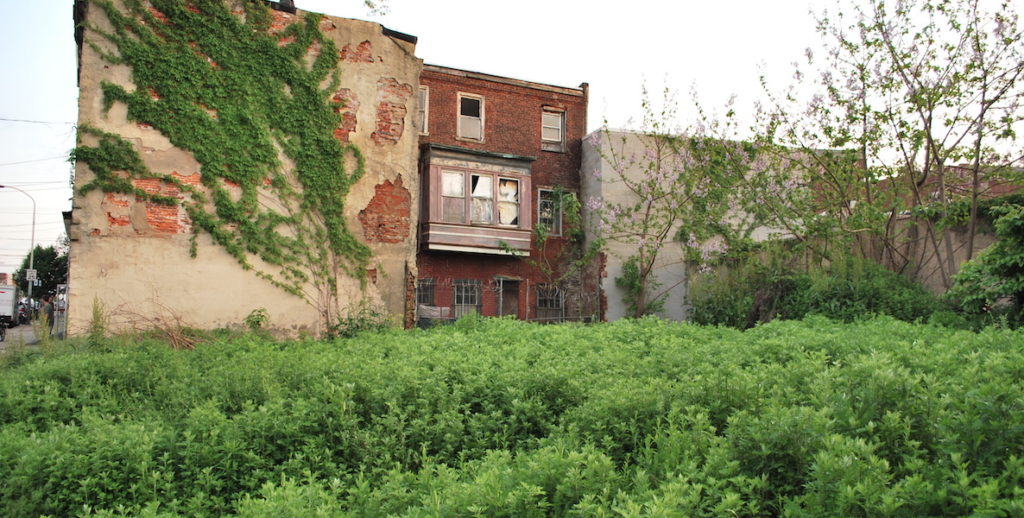A recent controversy that popped up last week over a weird “flag lot” development in Garden Court in West Philly, where a 30-unit mixed commercial building is going to be built essentially in the middle of the block behind a row of homes, provides an excellent example of what’s wrong with some Council members’ approach to neighborhood planning and zoning.
The story gets to the heart of some very different visions for what Council members’ role in the planning and development process should be like—namely, whether they should be more proactive or reactive.
In the 3rd District, which includes Garden Court, Council member Jannie Blackwell has been the poster child for Team Reactive, and this story shows why that’s just as likely, if not more likely, to result in bad projects happening as with a discretionary Council-driven process. Neighbors were warning Council member Blackwell this very thing could happen for years, and she never did anything about it because she didn’t want to pass the zoning remapping bill supported by neighbors and the Planning Commission.
The opposite of a Councilmanic Prerogative-driven process is neighborhood planning. The alternative to District Council members reactively calling all the shots isn’t a “bureaucrat” making all the decisions, as Council President Darrell Clarke has suggested—it’s neighbors working proactively with planners and Council to balance and prioritize a bunch of different interests before foreseeable problems arise.
Some Council members just never got on board with the Philadelphia 2035 Plan
Since Michael Nutter’s first term as Mayor, the Planning Commission has been working on an award-winning city plan called Philadelphia 2035 where they’ve been going district by district to 18 different regions (“Planning Districts”) of the City to gather information about things like the local housing stock, transportation options, commercial corridors, public facilities, anchor institutions, and more.
It was a huge undertaking that took years, with dozens and dozens of community meetings and consultations with local groups and Council people—at least the ones who chose to participate—and now all those plans are complete and available to read on their website.
![]()
By front-loading the community engagement process, the idea is that local groups don’t need to host a public meeting about every last thing because most of the zoning will be correct and informed by the neighborhood’s democratically-chosen goals.
Some Council members like Maria Quinones-Sanchez, Darrell Clarke, and Curtis Jones have bought into this idea and run with it. Others, like Cherelle Parker, have used the Planning Commission’s expertise to help advance her constituents’ planning goals for commercial corridors in the 9th District. Maria Quinones-Sanchez, in particular, has leaned into the remapping process and is on track to finish remapping all the neighborhoods in her district pretty soon. Here’s a somewhat outdated map from 2016 showing what had been accomplished 5 years into this process.
Other members, like Jannie Blackwell and Kenyatta Johnson, have never gotten on board the whole concept of neighborhood remapping, because they do want to have a discretionary process most of the time and play deal-maker on every single project that comes up. They’ve each remapped some areas of their districts in response to community pressure, but they haven’t touched most of them, and have said publicly on multiple occasions that’s because they want to maximize their own discretion.
Proactive vs. Reactive
The Blackwell/Johnson strategy involves leaving a lot of the district’s zoning inappropriately mapped—not matched to what’s there already, or what somebody might want to use land for, or consistent with the Philadelphia 2035 plan’s goals—and then hoping that nobody builds the thing that’s allowed within the rules and tries to get a legal exception (variance) to do something different—a process that triggers Council’s involvement and some politicking.
And that’s exactly the kind of approach that resulted in a 30-unit building getting by-right zoning approval for the donut hole in the middle of a bunch of people’s backyards in Garden Court.
(The purple shape is the lot in question)
PlanPhilly reports that neighbors knew for years something like this could happen on this oddball lot because of its inappropriate zoning, and asked Council member Jannie Blackwell to remap the neighborhood, but she never did it. Somebody pulled permits to do what’s allowed there—a three-story mixed residential and commercial building—and now it’s happening.
Via Jake Blumgart:
The vast property is zoned to allow for mixed-use development, so the three-story project can move forward without any public hearings. A bill that would have remapped the parcel for single-family housing, to match the surrounding areas, was delivered to Councilwoman Jannie Blackwell by the Planning Commission last year, but she never introduced it. Because the remapping never happened, neighbors have little leverage over the project unfurling in their literal backyard.
Neighborhood group have raised concerns about the parcel’s zoning for years. Blackwell’s office met with neighborhood residents and city planners about a proposed single-family rezoning of the lot — as part of a larger remapping effort — but the councilwoman never acted on the legislation that came out of the conversations. She did not return a call for comment.
“We’ve been waiting for action from the council person for a while,” Maciunas said. “That bill would have made this a moot point.”
The way that Council member Blackwell normally likes to use Councilmanic Prerogative, it’s all about stepping in at the last minute to put out a fire. But this situation shows how that approach is just as often likely to fail. Council members
Not coincidentally, the proactive approach is what 3rd District Council challenger Jamie Gauthier—a trained urban planner who Philly 3.0 has endorsed in the primary—is running on, according to her campaign’s website:
Jon Geeting is the director of engagement at Philadelphia 3.0, a political action committee that supports efforts to reform and modernize City Hall. This is part of a series of articles running in both The Citizen and 3.0’s blog.



